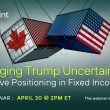by Craig Basinger, Chris Kerlow, Derek Benedet, Shane Obata, Connected Wealth, Richardson GMP
We all know there is safety in numbers. It’s more comforting being part of a group that thinks or behaves in a similar fashion. Just look at your friends: you probably have more similarities than differences. Otherwise you might not get along as well. Many investors also feel more comfort in being part of a crowd. Have you ever wondered why it’s standard marketing practice to show a fund’s top 10 holdings? If transparency is the goal, shouldn’t all holdings be shown as well as the sector breakdowns? This information tells you much more about how an investment will perform than looking at the top 10. But if you own a few of those top 10s, you start thinking you like the fund because their managers think like you. Or confirms your views.
However, what many investors learn over their careers is that being part of the crowd leads to crowd-like performance. And often, that’s not a good thing. More importantly, while lonely, better gains are often found being contrarian. You may not have as many friends and your peers may think you’re a bit “out there”. But most of the great investors in history were contrarian and were often found with positions betting against the crowd.
How to be Contrarian
Sometimes betting against the crowd can be a long-term endeavour. For instance, most would agree uranium is extremely out of favour at the moment. And with good reason: Japanese reactors have been very slow to restart following the Fukushima disaster back in 2011. This has led to far too much inventory globally and pushed the spot price down to around $20/lb. Before the disaster, uranium traded over $60/lb. And let’s not forget Germany going 100% non-nuclear. At current prices, just about everyone is losing money. The estimated marginal cost is around $40/lb. Bad news, right? But the higher quality, lower cost, less levered producers will likely survive. And the longer the price remains this low, more production will be curtailed. It does fix itself, it just takes a long time. You could probably make a lot of money in uranium if you had a five+ view. At some point the cycle will go the other way. But will that ever be a lonely position, making you look foolish while you patiently wait for the good news that could be years away.

Sometimes betting against the crowd can be a shorter term endeavour. During strategy development for our behavioural finance fund, we found how companies react to earnings to be a good source of contrarian opportunities. The premise was relatively straightforward: the market often overreacts to earnings and we believe this is caused by a number of factors. Recency bias, a well-documented behavioural bias, causes investors to react, placing a disproportionally high weighting to recently released information that can often cloud or cause the market to ignore the longer term picture. Betting against this reaction is contrarian and has proven to be profitable.
Earnings Overreaction
Generally speaking, companies experiencing a significant one-day price move (up or down) tend to see a continuation of the move over the next one to four weeks. Or, more simply, a company with a strong positive price surprise to earnings tends to see continued small gains afterwards. And a company with a negative price surprise tends to see continued negative moves (top chart). This is clearly not evidence of an opportunity for a contrarian. But there are scenarios that will often see an opportunity.


One scenario that appears potentially profitable is companies trading in an established uptrend, that then experience a negative earnings result will often see that loss reduced over the coming weeks (chart 2). Investors will often view a company doing well that misses its earnings estimate as a buying opportunity. This causes more investors to be attracted to the company relative to those who were disappointed in the result. This is clearly a contrarian opportunity, as the market reacts to the negative earnings news to buck the trend and go long.
Note: The top two charts are based on data from the TSX 60 constituents over the past five years. Looking at price reactions following earnings that was either +/- 4% as a threshold for a surprise.
More recently, we have been implementing an earnings overreaction stractegy during the last earnings season. This took into account a number of factors including whether companies were in an up or down trend and the quality of the company. It also tends to trade before the end of the first day following earnings. Very often, the overreaction occurs in the early portion of the trading day, then begins to dissipate.
Down markets in February clearly cloud things, with the average long position being slightly negative and the shorts being strongly profitable. Adjusting for the market moves, both long and shorts have on average been profitable. While still early in live data, this is encouraging evidence that the market does often overreact to earnings, creating a contrarian opportunity.
Being Partially Contrarian
We would never suggest investors become 100% contrarian, but adding a portion of capital to implement contrarian strategies has a couple benefits. One, if the contrarian strategy does succeed, often strong results will ensue. It was contrarians who went against sub-prime housing. Deep value investing, which is contrarian, has a good long term track record of adding value. The other benefit is diversification. If most investments are with the crowd, which tends to be more performance chasing, a contrarian strategy will often perform very differently. This can help diversify a portfolio.
Copyright © Connected Wealth, Richardson GMP















